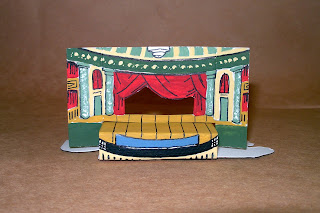
Playlab NYC is excited to present Poe-Dunk – A Matchbox Entertainment as a part of the 2012 FRIGID New York Festival. Poe-Dunk is an itty-bitty puppet repertoire of obscure curios, marginalia, and even a couple popular classics from America’s most versatile writer. It is conceived and performed by Playlab NYC’s artistic director Kevin P. Hale and directed by John Pieza. Originally a part of the 15th Annual New York International Fringe Festival, this production promises an enjoyable time with opening night Wednesday, February 22nd at 6:30pm.
Poe-Dunk – A Matchbox Entertainment is centered on the works of Edgar Allan Poe and features the artwork of Kevin P. Hale. Out of a passion for toy theaters and Poe, Kevin initially created a few matchbox theaters inspired by Poe’s poems as a hobby. Poe-Dunk is a must see for lovers of Poe and the art of toy theater. Of Poe-Dunk Kevin said, “The collection of stories and essays from Poe is so vast that you can forget that not only was he a poet and horror writer, but he was also a newspaperman, a playwright, a critic and humorist. I confess to spending a lot of time reading and researching this writer since my years in high school and I still find him fascinating. I want the audience to share in my fascination.”
Poe-Dunk – A Matchbox Entertainment is based on the writings of Edgar Allan Poe, conceived and performed by Kevin P. Hale. It is produced by Playlab NYC, directed by John Pieza, with sound by Trevor Dallier, and lights by Jennifer Linn Wilcox.
Founded in 2008, the members of Playlab NYC are mad scientists of imagination. They concoct, unleash and support enjoyably absurd and absurdly enjoyable amusements that engage artists and audiences in the spirit of play. Past works include: Goldilocks and the Three Polar Bears, a co-production with Wide Eyed Productions (FringeNYC 2011); The Altoona Dada Society Presents: The Velvet Gentleman, presenting the unusual life of composer Erik Satie (FringeNYC 2010); Professor Ralph’s Loss of Breath, based on a short story by Edgar Allan Poe (FringeNYC 2009); Perfectly Natural, four fables from a different perspective (Midtown International Theater Festival 2009); and The Tempest, Shakespeare’s tale of magic, forgiveness, and fathers (Socrates Sculpture Park 2008). For more info visit www.playlabnyc.org.
Poe-Dunk – A Matchbox Entertainment runs February 22nd – March 3rd 2012, Wednesday, February 22 at 6:30 PM; Friday, February 24 at 9:30 PM; Monday, February 27 at 8:00 PM; Wednesday, February 29 at 11:00 PM; and Saturday, March 3 at 12:30 PM. The Red Room is located in the Lower East Side at 85 East 4th Street (2nd and 3rd Ave) - - accessible from the N,R (8 St-NYU) or 4, 6, 6x (Bleecker) stop. Tickets are $12 available at www.smarttix.com.
FRIGID New York was founded by Horse Trade and EXIT Theatre in 2007. FRIGID New York is a non-juried festival where participants are chosen by lottery, and 100% of ticket sales are returned to the performing company. They take a total of 30 participants.

















































